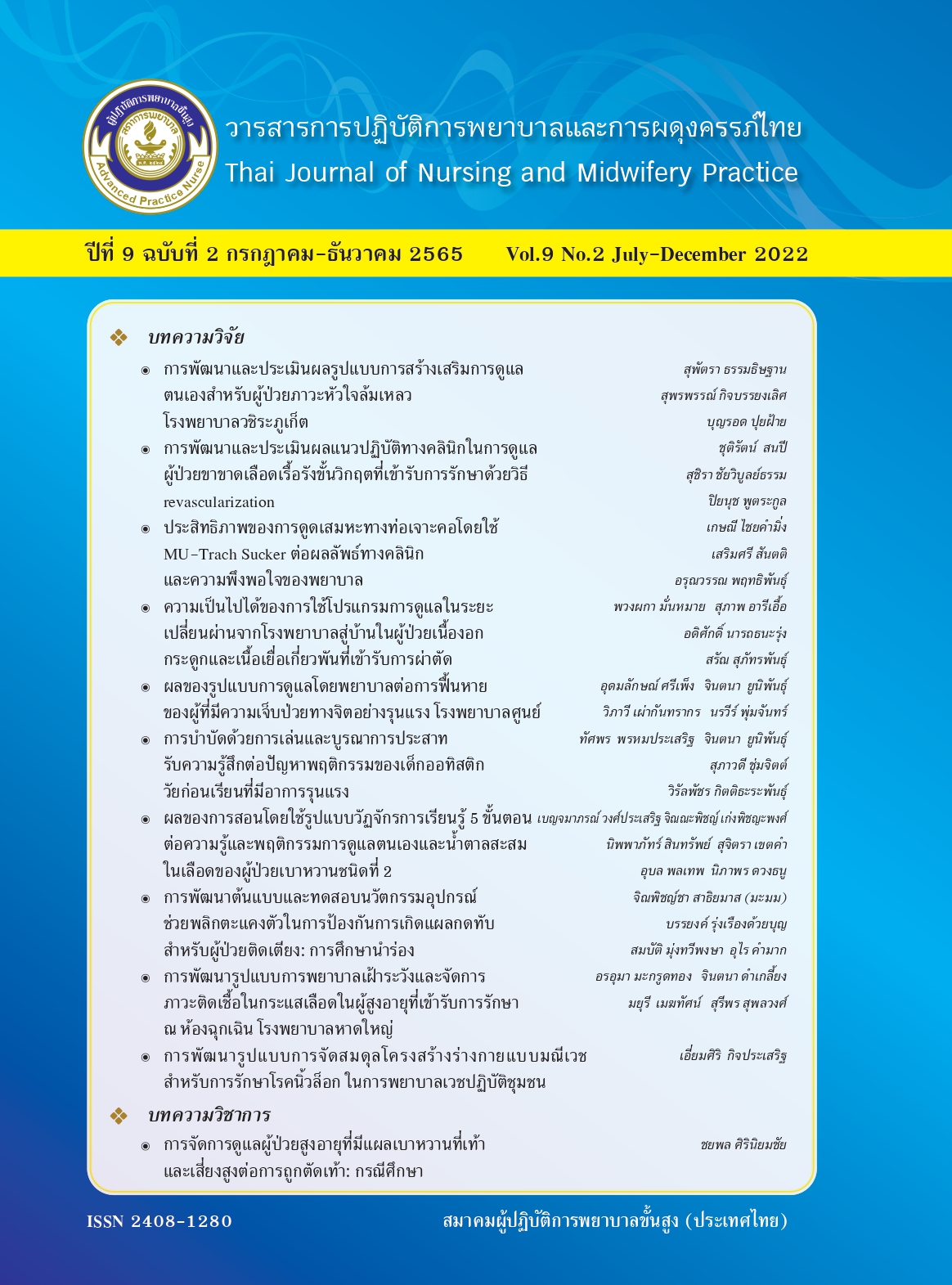Development of Nursing Model for Monitoring and Management of Sepsis in Older Adults at Emergency Room, Hatyai Hospital
Main Article Content
Abstract
The purpose of this study was to develop nursing model for monitoring and management of sepsis in older adults admitted to emergency room (ER), Hatyai hospital. Participants were 36 emergency nurses and 55 older persons with sepsis. The study was conducted in three phases, including 1) situation analysis by conducting focus groups with emergency nurses, 2) development and implementation of a nursing model for monitoring and management of sepsis in older adults, and 3) evaluation both nursing and patient outcomes. The instruments were validated, and test for reliability using the percentage of agreement yielding of 1.00. Data were analyzed using descriptive statistics, and t-test. The results showed that emergency nurses’ knowledge on nursing management of older adults with sepsis was significantly higher than before. The feasibility of using the nursing model in total and each item were at a high level. Nurses’ satisfaction in every item was at a high level. Patients’ outcomes showed that the percentage of assessment and nursing care delivered to older adults was at 92.73-100. Older adults with sepsis received correctly triaged at 98.18%, were monitored and managed correctly at 96.12%, were evaluated and monitored during transferred to another department at 99.44%. SOS score was decreased from admission. In conclusion, this nursing model could be applied in improving quality of nursing care for monitoring and management of older adults with sepsis and achieving optimal outcomes.
Downloads
Article Details

This work is licensed under a Creative Commons Attribution-NonCommercial-NoDerivatives 4.0 International License.
References
World Health Organization. Sepsis. Geneva: World Health Organization 2020. [Internet]. [cited 2020 March 1] Available from: https://www.who.int/news-room/fact-sheets/detail/sepsis.
Rowe TA, McKoy JM. Sepsis in older adults. Infect Dis Clin North Am. 2017; 31(4): 731-42.
Baldwin LN, Smith SA, Fender V, Gisby S, Fraser J. An audit of compliance with the sepsis resuscitation care bundle in patients admitted to A&E with severe sepsis or septic shock. International Emergency Nursing. 2008 Oct 1;16(4):250-6.
Khwannimit B, Bhurayanontachai R. The epidemiology of, and risk factors for, mortality from severe sepsis and septic shock in a tertiary-care university hospital setting. Epidemiology & Infection. 2009 Sep;137(9):1333-41.
Levy MM, Evans LE, Rhodes A. The surviving sepsis campaign bundle: 2018 update. Intensive care medicine. 2018 Jun;44(6):925-8.
Masterton RG. The new treatment paradigm and the role of carbapenems. International Journal of Antimicrobial Agents. 2009 Feb 1;33(2):105-e1.
Mahavanakul W, Nickerson EK, Srisomang P, Teparrukkul P, Lorvinitnun P, Wongyingsinn M, Chierakul W, Hongsuwan M, West TE, Day NP, Limmathurotsakul D. Feasibility of modified surviving sepsis campaign guidelines in a resource-restricted setting based on a cohort study of severe S. aureus sepsis. PLoS One. 2012 Feb 1;7(2):e29858.
Strategy and Planning Division. Public Health Statistics.Bangkok: Ministry of Public Health; 2018. 157 p. Thai.
Hatyai Hospital Statistics. [Internet]. Songkhla: Hatyai Hospital; 2019 [cited 2020 February 1]. Available from: https://www.hatyaihospital.go.th/web/site2019/index.php.Thai.
Thai Society of Critical Care Medicine. Severe sepsis and septic shock. [Internet]. Bangkok: Thai Society of Critical Care Medicine; 2015 [cited 2021 June 1]. Available from: http://www.ayhosp.go.th/ayh/images/HA/miniconf/5.pdf. Thai.
Sripiboonbat J. Outcomes of Care for the Elderly with Sepsis in the Accident and Emergency Department. 2019. Thai.
Magrudthong O, Damkliang J. Outcomes of the Development of an Initial Assessment and Nursing Management Guideline for Older Persons with Sepsis in Emergency Department. Songklanagarind Journal of Nursing. 2021 Sep 28;41(3):60-73.
Donabedian A. An Introduction to Quality Assurance in Health Care. Oxford University Press. 2003.
The Surviving Sepsis Campaign Bundle: 2018 update. [Internet]. [cited 2020 March 1] Available from:https://link.springer.com/content/pdf/10.1007/s00134-018-5085-0.pdf
Narakun B. Research Methods in Nursing Science. Bangkok: U&I Inter Media Co., Ltd. 2010. Thai.
Srithundorn S. Nursing practice system development in using protocol for persons with sepsis syndrome in emergency department. 2013.
Prompriang P, Chitreecheur J, Boonchuang P. Effects of Evidence-based Practice Promotion for Infection Prevention on Knowledge and Practices among Nurses and Incidence of Peripheral Intravenous Infection in a Community Hospital. Thai Journal of Nursing Council 2009; 24:31-41.
Suwanpol T, Samantarath P, Sata J, Kongkulthong P. (2020). Evaluation of Knowledge and Practice of Nurses Before and After Implementation of Clinical Practice Guideline for Prevention of Central Venous Catheter Related Blood Stream Infections (CRBSI) in Neonatal Surgical Patients. Journal of The Department of Medical Services, 45(4), 129-137.Thai.
Nasuwan W. Development of the Nursing Service System for Patients with Severe Sepsis. 2014. Thai.
Kosol S, Chukumnerd P, Thongsuk P. Development of a Management Model in Keeping Leukemia Patients under Surveillance of Septicemia in Suratthani Hospital. Jounal of southern technology, 14(1), 97-111. 2020. Thai.
Paisarn K. The Development of Triage System in Emergency Department at Phon Hospital, Khon Kaen Province. 2019. Thai.
Boonmee L. The Effectiveness of Septicemia Syndrome Nursing Practice Program at Damnoensaduak Hospital in Ratchaburi Province. 2020. Thai.


